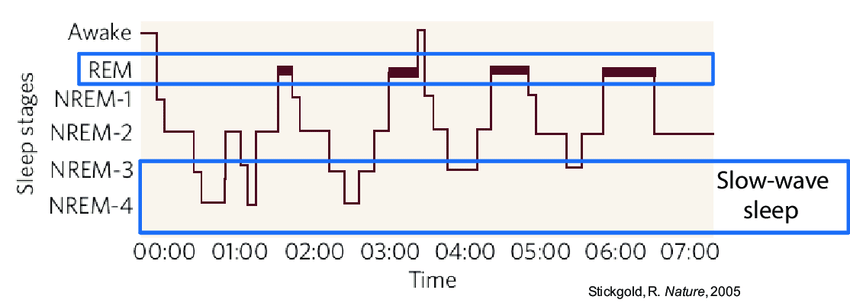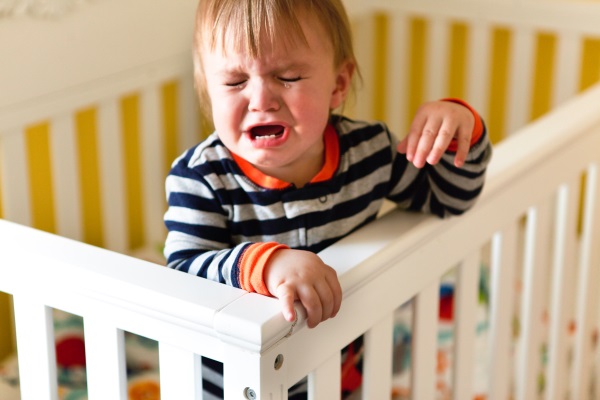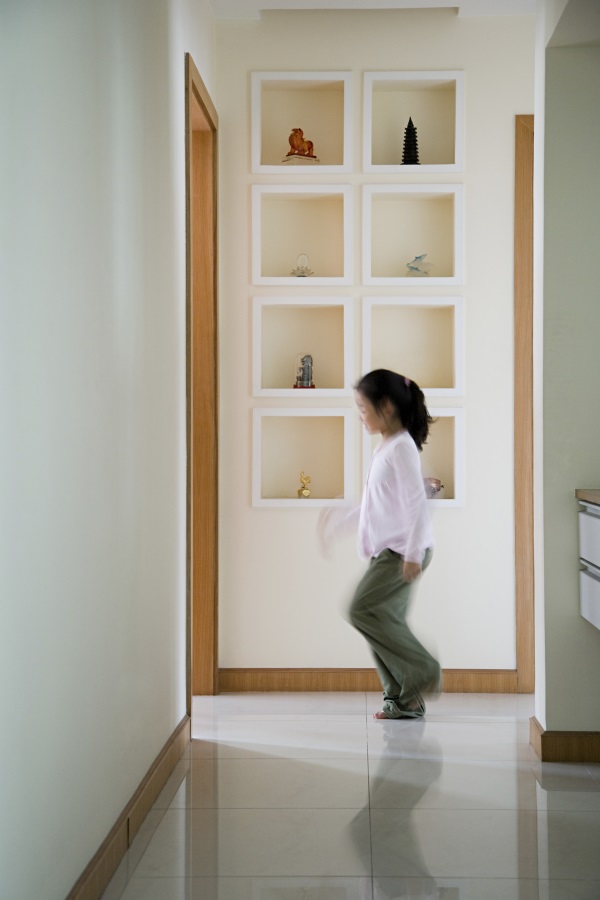Sleep Difficulties in Children & Adolescents
Most children and adolescents experience sleep problems at some stage. Sleep problems may not necessarily meet diagnostic criteria but are nevertheless a source of considerable distress for both children and their families due to a reduction in the child’s overall functioning and wellbeing.
Sleep disorders are classified into two main categories:
- Parasomnias
- Dyssomnias
The Sleep Cycle

The alternation between sleep and wake typically follows a 24-hour cycle, which is synchronised to the person’s physiology, as well as their social and physical environment. Each person’s cycle reflects the spontaneous rhythm of the endogenous circadian pacemaker, often referred to as the biological clock. The circadian rhythm is regulated by the brain’s pineal gland. The pineal gland produces and secretes the hormone melatonin that helps regulate biological rhythms (including sleep-wake cycles). The secretion of melatonin is inhibited by light and triggered by darkness.
Sleep occurs in a rhythmic pattern that is characterised by five distinct physiological stages, which are cycle through several times during a night’s sleep. The most important stage appears to be rapid eye movement (REM) and slow wave sleep (SWS), since both support several vital functions. Evidence suggests that SWS has a restorative and regenerative purpose in regions of the brain including the cerebellum.
While it is likely that sleep involves restorative and information storage processes, there remains no comprehensive and unequivocal answer to ‘why do we sleep?’. Nevertheless, the debilitating effects of inadequate sleep, and the breakdown of physical and cognitive development without it, are a sound indication that good sleep is crucial.
Normal Sequence of Sleep

Although sleep is controlled by the same neural mechanisms in all people, the structure and pattern of sleep varies across age groups. Children are born with a multiphasic sleep pattern that does not develop into an adult-like monophasic sleep pattern for many years. Throughout development, a mature sleep-wake rhythm emerges as the child’s sleep begins to sync with the 24-hour environment. Gradually, the child’s sleep-wake pattern will become progressively shorter, with the child requiring fewer naps during the day in favour of a longer sleep episode at night. A monophasic pattern of sleep, synchronised to the environment, emerges at ages of 2-5, when the child completely abandons the daytime nap. The total amount of sleep each 24-hour period, and the total amount of REM sleep required, follows a developmental time course. Both steadily decreases with age, from ~16 hours per day in newborn babies to ~ 8 hours per day in 17-year-old adolescents.
Thus, the normal range of sleep duration in children varies enormously with age.
In addition to there being considerable differences across age groups, there is considerable variation in the sleep patterns of children of the same age. For example, the parameters for normal sleep in a typical 5-year-old ranges from about 8 to 13 hours of sleep, with or without daytime naps. Due to the significant natural variance in sleep requirements, it is difficult to definitively pinpoint where normal sleep finishes and abnormal sleep begins.
PARASOMNIAS
Parasomnias are disorders of arousal, partial arousal, and sleep stage transitions (i.e., the activation of the physiological systems at inappropriate times during the sleep cycle). Such physiological systems include the autonomic nervous system, motor system, and other cognitive processes. People who suffer from parasomnias usually present with complaints of unusual behaviours during sleep such as:
- Nightmare Disorder
- Sleep Terror Disorder
- Sleepwalking Disorder
- Parasomnia not otherwise specified
(1) NIGHTMARES - CONNECTED TO THE REM SLEEP CYCLE
Diagnostic Criteria
- Essential feature is the repeated occurrence of frightening dreams that lead to awakenings from sleep;
- Becoming fully awake, oriented, and alert;
- Significant distress or a reduction in occupational functioning;
- Occurring during the REM (rapid eye movement) sleep stage;
- Nightmares are not part of another disorder.
Differential Diagnosis
- Happen during the middle and latter portions of the night during REM sleep
- Presence of vivid dream imagery
- Any verbalisations are subdued
- Moderate physiological arousal
- Slight or no movements
- Easy to arouse and responsive to environment
- Episodes are frequently remembered.
(2) SLEEPWALKING - CONNECTED TO DELTA (SLOW WAVE SLEEP)
Diagnostic Criteria
- Repeated episodes of rising from bed during sleep and walking about
- Leaving the bed and walking around; often in automation
- Occurs during stages of SWS
- No memory of the episode the next day
- Within several minutes after awakening, there is no impairment of mental activity/behaviour (but could be confused)
- Distress or impairment in social/ occupational or other areas
- Not the result of other physiological disorders.
Differential Diagnosis
- Sitting upright in bed; eyes are open but appear ‘unseeing'
- Tends to move in a confused and clumsy manner that becomes more coordinated
- Stays in the bedroom, either generally or looking for something specific
- It is impossible to catch their attention - if left alone the person goes back to their bed
- The person navigates around the room through memory of the room layout (which seems to be heightened while asleep)
- If the person is blindfolded, and does a similar route while awake, they will not have the same navigational success and are more likely bump into things
- Sometimes injuries occur
- Sometimes adventurous or risky activities occur e.g., going to the fridge and getting dressed
- Note: if these activities become more complex (e.g., getting dressed then riding a bike this is less likely to be sleepwalking and more likely to be a confused arousal into wakefulness)
- Disturbing mental events can occur.
(3) NIGHT TERRORS - CONNECTED TO DELTA (SWS) SLEEP CYCLE

Diagnostic Criteria
- Recurrent episodes of abrupt awakening from sleep, during the first third of night, the person wakes screaming and/or crying
- Intense physiological arousal (increased heart rate, profuse sweating, pupils dilated) and fear
- Occurs during non-REM sleep, that is Delta SWS and can be associated with sleepwalking
- Person is difficult to comfort
- The person has very limited or no memory of the episode
- The episodes cause significant distress and/or impairment in social/occupational functioning
- The disturbance is not due to the direct physiological effects of a substance.
Differential Diagnosis
- People can suffer isolated episodes of sleep terror, but a disorder is diagnosed on the above criteria
- After the fright the person can awaken a little but is disoriented and confused
- There is motor activity and agitation. The person is difficult to arouse and unresponsive to the environment
- Verbalisations are usually present
- The person experiences sudden and horrifying sensations and imagery that shock them into wakefulness.
DYSSOMNIAS
Dyssomnias are noted in DSM as disorders of initiating or maintaining sleep, or of excessive sleepiness, which result in a disturbance in the quality, amount, or timing of the sleep. Signs of poor sleep quality include not feeling rested after sleep, being unable to maintain sleep, excessive sleeping, and sleep timing problems such as an inability to fall asleep during conventional hours.
Problems of sleep timing constitute an inability to sleep during ‘normal’ day/night sleep times, which highlights the nature of sleep as a social construction.
Factors Involved in Sleep Disorders
Childhood sleep disorders are often viewed as a manifestation of a child’s neurophysiological development, which subsides as they develop. However parental and environmental factors play a role in the development of sleep disorders. Poor sleepers are less able (or willing) to return to sleep and tend to wake their parents. Most children who sleep well can self-sooth to settle back into sleep (e.g., by looking around, hugging a toy, or sucking a thumb. In contrast, poor sleepers are less able to self-soothe due to a lack of serotonin and/or melatonin neuromodulation. In a sample of over 6000 children, QEEG brain imaging at BNC has shown that, for those experiencing poor sleep, there are low levels of Delta and Alpha power in the brain. Others have excessively high Beta power levels associated with a Streptococcus overgrowth in the bowel.
Both these abnormal brain patterns can be treated with dietary changes and nutrient supplementation.
DIFFICULTIES GOING TO SLEEP
Sleep-onset association disorder is an impairment (or absence of) sleep initiation without certain circumstances or objects (e.g., a pacifier, bottle, being rocked, or the presence of a parent). When the desired circumstances or object are present sleep initiation problems cease. Similarly, limit-setting sleep disorder is thought to be an environmental problem that occurs in 5% – 20% of children between the age of 6 months and 3 years, although it may persist longer.
MILK-INTOLERANCE
Very little is known about this disorder beyond the fact that milk-intolerance can lead to sleep initiation and maintenance problems. Milk-intolerance disorder was highlighted in a study that examined a sample of 147 children referred for sleep problems. Of the 147 children, 58% were diagnosed with inappropriate sleep habits, 10% had minor problems (mostly parental anxiety), 5% had a poor sleeping environment, and 15% were diagnosed with parasomnias. The remaining 12%, despite experiencing symptoms (e.g., frequent night awakenings) for 13 months, did not receive a diagnosis. No diagnosis was made since an intolerance to cow’s milk was the suspected cause. 15 of the 17 children without a diagnosis, but had symptoms, were placed on a diet that excluded dairy products and their symptoms resolved. The children’s sleep had normalised within 5 weeks of commencing the dairy-free diet. Other children were given a double-blind milk challenge with symptoms recurring in 14 of the 15 children. The milk challenge was repeated at a 1-year follow-up with 10 children. All but one child reacted as before.
INTESTINAL DYSBIOSIS
Intestinal Dysbiosis is a term used to describe a disordered ecology of gut bacteria. Some bacteria populations become overgrown for a variety of reasons, at the expense of other bacterial varieties. Toxic bacteria create by-products that trigger the brain into a state of hyperactivity which keeps the person awake and sometimes causes anxiety and panic attacks. If the child’s bowel function is not normal in its form and regularity, or if the child frequently complains of tummy aches, please contact BNC for advice.
An overgrowth of Streptococcus is associated with anxiety, panic attacks, restless sleep, and night terrors in children. A diet high in sugars and refined carbohydrates (in bread, pasta, cereal grains etc.) causes the bowel to become too acidic, prompting Streptococcus overgrowth associated with sleep and behavioural issues.
NIGHT-TIME FEEDING

It is difficult to define ‘normal’ night-time feeding. It is generally believed that by the age of six months an infant should be able to satisfy all their food requirements during the day. Thus, whilst it might be normal for a 6-month-old to wake once or twice at night to feed, it would be considered abnormal for infants of that age to wake more than three to four times per night to eat. If this is the case, the infant may not be receiving enough nutrients throughout the day. Food intake is not necessarily the same as nutrient intake. The best diet is not processed, but homemade from unprocessed foods such as legumes, vegetables, fish, and meat. All flour-based foods are highly processed and low in nutrients.
SLEEP-WAKE RHYTHM DISORDER
Sleep timing is controlled by the circadian rhythm which can become disordered. Some people cannot fall asleep until 3:00AM-5:00AM, after which sleep is of good quality but of insufficient quantity due to societal demands. Sleep-wake rhythm disorder can be chronic and last for decades. However, some peoples’ sleep-wake cycle spontaneously corrects itself.
If you have a child with an abnormal sleep-wake cycle, please call BNC for advice.
SLEEP APNEA
Sleep apnea is associated with excessive daytime sleepiness and involves airway obstruction during sleep. This, in turn, leads to decreased oxygen saturation in the blood that causes the sufferer to briefly awaken many times throughout the night. Sleep apnea is often accompanied by heavy snoring and is commonly caused by enlarged tonsils or excessive mucous production in children. Other causes of sleep apnea include a small oropharynx, obesity (especially of the neck), micrognathia (an unusually small jaw), chronic upper airway infection, rhinitis (an inflammation of the mucous membranes of the nose), and hay fever. In such cases, an examination by a Paediatric Respiratory Physician or Sleep Specialist is required.
Treatment
NIGHTMARES AND NIGHT TERRORS
Because there are developmental, physiological, and environmental causes of sleep disorders, no one treatment is considered the most effective. For example, stress at home/school and anxiety disorders often co-occur with nightmares. As such, an individual consultation is necessary before treatment plans can be recommended.
In our experience at BNC, nightmares and night terrors are frequently associated with an overgrowth of streptococcus in the bowel, with a change in diet making a big difference to symptom improvement.
Most therapies for nightmares tend to involve techniques to reduce anxiety such as relaxation and parental counselling. Sedatives and/or melatonin supplementation are only considered helpful as a last resort (depending on the severity and duration of the problem).
In many cases, therapy is not needed because the nightmares disappear on their own. If therapeutic intervention is required, nightmares and night terrors are addressed through a combination of medication, education regarding the nature of the problem, dietary changes, relaxation techniques, and parental counselling – all of which have proven to be effective. Unfortunately, these interventions do not treat potential underlying causes such as daytime stress and anxiety. A combined approach can produce the best outcomes.
SLEEP WALKING

In the late 1960s, Professor Barry Sterman at UCLA discovered that there are alpha rhythms in the brain, termed ‘sleep spindles’, which do not appear in restless sleepers, people with restless legs, and sleepwalkers. Sterman successfully promoted sleep spindles in subjects’ brains using EEG biofeedback (Neurotherapy) and has continued to publish extensively on this topic. Since episodes of sleepwalking are often triggered by anxiety, parental reassurance is always important because a parent’s concern is often sensed by the child who becomes more anxious and, in turn, sleepwalks more.
Sleepwalking can be benign – a habit that is broken by making changes to a child’s sleeping environment (e.g., changing their bedroom for a few days). It is not recommended to try and wake a sleepwalking child as they may become distressed. We recommend guiding or carrying them back to bed.
DIFFICULTY GOING TO SLEEP
Behavioural techniques are more successful than sleeping tablets, but before behavioural interventions commence, causes such as colic, milk intolerance, sleep phobias, and/or nightmares need to be ruled out and treated appropriately. If the child feels safe during waking hours, the most effective behavioural technique involves tucking the child in at bedtime, leaving the bedroom, and not returning until the child is asleep. Failing this, the parent can briefly re-enter the bedroom to ensure the child has no physical complaints. The first night is often difficult for all involved, but if this routine is applied consistently and correctly, rapid progress is made. Controlled crying is not useful in the long term since it teaches learned helplessness. Halfway measures, such as allowing the child to cry for 20 minutes before intervening is also counter-productive because the child’s crying is positively reinforced.
DAIRY INTOLERANCE
If dairy intolerance is suspected, the obvious treatment is to withdraw milk products from the child’s diet. In the study, sleep was normalised within 5 weeks in 15 out of the 17 subjects. At follow-up, involving the reintroduction of milk, sleep difficulties remerged for most.
NIGHTTIME FEEDING
Large nighttime feeds can create or compound sleep-wake problems, since feeding at night can exacerbate nappy-wetting for infants over 6 months since it causes discomfort that awakes them. Thus, it is recommended that feeds are minimised or stopped right before bed. We recommend a gradual reduction over a 2-week period, decreasing the availability of milk, and increasing the time between feeds. Success is often marked, and parents are surprised by how quickly the infant adapts (Horne, 1992).
SLEEP-WAKE RHYTHM DISORDERS
Children with free-running 25-hour sleep-wake rhythms can benefit from bright light therapy which blocks drift and resynchronises the sleep-wake rhythm. This therapy involves waking the child early, around 7.00am, and exposing the child to sunlight or bright ‘daylight lamps’. In the evening, the child should avoid bright white lights, in favour of warm lights, and avoid artificial light from TV, phones, or computer screens.
